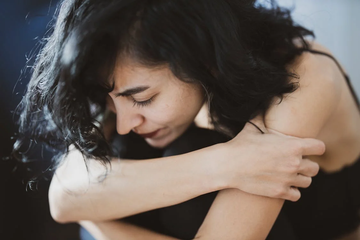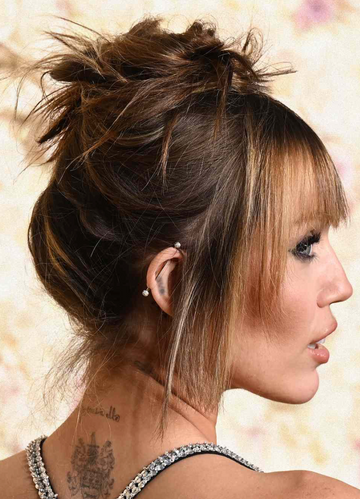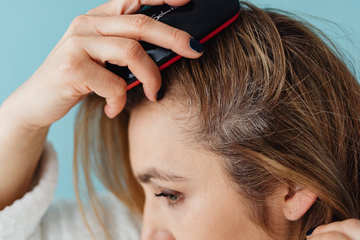The science behind iron and the hair cycle
Hair loss can feel sudden, distressing, and frustratingly hard to trace back to a single cause. For many, the usual suspects—stress, styling habits, or hormones—are the first to blame. But there’s one often-overlooked factor that could be quietly working against your hair: iron deficiency.
Iron plays a critical role in oxygenating your cells, including those that support healthy hair follicles. When your iron levels drop too low, your body redirects resources to more vital organs, leaving your hair, quite literally, out of the equation.
That’s why understanding the connection between iron deficiency and hair loss is so important. It’s not just about treating the symptoms; it’s about identifying a correctable root cause that could transform your hair (and overall health) in the process.
Below, we’re breaking down how iron impacts your hair, what signs to watch for, and what you can do if you suspect low iron is behind your thinning strands.
Why iron matters more than you think
Iron isn’t just a number on your blood test; it’s a vital mineral that powers nearly every system in your body. Its main role? Helping your red blood cells carry oxygen from your lungs to the rest of your tissues. This oxygen delivery is essential for cell growth, repair, and function, including in places you might not think about, like your scalp.
Hair follicles are among the most metabolically active structures in the body. They rely on a constant supply of oxygen and nutrients to fuel the rapid cell turnover that keeps hair growing. When iron levels drop too low, your body prioritises vital organs like the heart and brain. Hair? Not so lucky.
The result is often increased shedding, slower regrowth, and thinner strands overall. In some cases, iron deficiency may even push hair follicles into a resting phase, where growth halts completely.
If your hair is falling out and your iron levels are low—even if you’re not anemic yet—that could be part of the picture. Recognising this connection early can make all the difference when it comes to protecting your hair’s long-term health.
Does iron deficiency cause hair loss?
The short answer? It can. While not every case of hair loss is caused by low iron, mounting research suggests that iron deficiency may be a contributing factor, especially in women.
Multiple studies have found that people experiencing certain types of hair loss, particularly telogen effluvium and androgenetic alopecia, tend to have lower serum ferritin levels (a marker of stored iron). In a 2002 study published in the Journal of the American Academy of Dermatology, researchers noted that women with low iron stores were more likely to report chronic shedding, even if they weren’t officially anemic.
Why? Iron is critical to the hair growth cycle. When iron levels dip, hair follicles can prematurely exit the anagen (growth) phase and enter telogen (resting phase), leading to excessive shedding—a condition known as telogen effluvium. In this state, follicles lie dormant, producing no new hair for months.
The link isn’t fully understood yet, but many experts now consider low iron to be a modifiable risk factor for hair loss—meaning it’s something you can address and potentially improve with the right support.
Of course, correcting the deficiency takes time, and hair regrowth doesn’t happen overnight. That’s why many people turn to styling solutions in the meantime to help bridge the gap between treatment and visible results.
Recognizing the signs of iron deficiency
Iron deficiency often creeps in slowly, and because its symptoms can be subtle, it’s easy to overlook. But your body will usually send signals when your iron stores are running low.
Common symptoms of iron deficiency include:
– Persistent fatigue or low energy
– Pale or sallow skin
– Dizziness or light-headedness
– Cold hands and feet
– Brittle or ridged nails
– Cravings for non-food items like ice or clay (a condition known as pica)
– Shortness of breath or rapid heartbeat
Hair-related signs can show up as:
– Increased hair shedding, especially during brushing or washing
– Widening part or thinning at the crown
– Hair that feels weaker, finer, or breaks more easily
– Slow regrowth or patchy density
Because hair loss is often one of the last symptoms to appear, it can sometimes be the first one we notice. Suppose you’re seeing changes in your hair and experiencing any of the above. In that case, it may be worth asking your doctor to check your iron levels, particularly ferritin, the marker of iron stores.
Diagnosing iron deficiency
If you suspect iron deficiency is behind your hair loss, getting the right blood work is essential. A general blood test may not tell the whole story, so it’s important to request specific markers.
Key tests include:
– Serum ferritin: Measures your body’s iron stores. Even levels within the "normal" range can be too low to support healthy hair growth. Many experts suggest ferritin should be above 70 ng/mL for optimal follicle function.
– Hemoglobin and hematocrit: These indicate whether you're anemic, which can happen when iron levels are severely depleted.
– Total iron-binding capacity (TIBC) and transferrin saturation: These help assess how well your body is transporting and using iron.
Since iron levels can fluctuate and be affected by other conditions, it’s crucial to work with a medical professional who can interpret your results in context and recommend a personalized treatment plan. Self-diagnosing or over-supplementing without lab work can do more harm than good.
Treatment options
The good news? Iron deficiency is one of the most treatable causes of hair loss, and even small changes can make a big difference over time.
Dietary changes are a great first step. Focus on iron-rich foods like:
– Red meat, liver, and poultry
– Spinach, lentils, and tofu
– Pumpkin seeds, quinoa, and fortified cereals
Pairing iron-rich foods with a source of vitamin C (like citrus fruits, bell peppers, or tomatoes) can help increase absorption, especially from plant-based sources.
For more significant deficiencies, iron supplements may be necessary. These come in various forms—ferrous sulfate, gluconate, or bisglycinate—and should always be taken under a doctor’s supervision. Dosage, timing, and potential interactions with other nutrients (like calcium) all play a role in how effective and tolerable a supplement is.
Given that iron takes time to rebuild in the body, results won’t be immediate. Most people won’t notice hair changes for at least 3–6 months. In the meantime, hair toppers, extensions, and volumizing pieces can be a helpful confidence boost, offering the look of fullness while your body works on regrowth behind the scenes.
Preventing hair loss due to iron deficiency
When it comes to iron-related hair loss, prevention is always easier than treatment. Small, consistent habits can go a long way in protecting both your overall health and your hair.
1. Start with regular health check-ups. Annual bloodwork can help you monitor your iron and ferritin levels—especially if you're menstruating, pregnant, vegan, or have a history of deficiency. Early detection can stop hair loss before it starts.
2. Next, maintain a balanced, iron-rich diet. Incorporate a mix of animal and plant-based iron sources along with vitamin C-rich foods to aid absorption. Staying hydrated and limiting processed foods also supports better nutrient delivery to your hair follicles.
3. Lastly, be kind to your hair. Adopt gentle hair care routines: avoid tight hairstyles, limit high heat styling, and use sulfate-free shampoos that won’t strip your scalp. Healthy hair starts with healthy habits—and that includes what’s on your plate and how you treat your strands.
When to seek further help
If you’ve addressed your iron levels and are still experiencing excessive hair shedding, thinning, or fatigue, it’s time to talk to a professional.
Persistent symptoms may indicate a more complex issue, like chronic inflammation, hormonal imbalance, or a secondary nutrient deficiency. A dermatologist or trichologist can assess your scalp health, recommend targeted treatments, and help rule out other causes of hair loss.
You deserve answers—and options that work. Don’t wait too long to advocate for yourself. The earlier you seek specialised care, the better your chances of seeing meaningful results.
Iron, hair, and the bigger picture
Iron deficiency won’t be the cause of every case of hair loss, but when it is, the impact can be significant. Understanding the link between low iron and follicle health is key to addressing the problem at its root.
If you’re noticing unusual shedding, thinning, or fatigue, don’t ignore it. A simple blood test could hold the answer. And while restoring your levels takes time, your confidence doesn’t have to wait.
The Lauren Ashtyn Collection (TYME’s sister company) offers handcrafted, salon-quality hairpieces that provide instant volume and coverage, so you can feel like yourself again while giving your body the care it needs.




